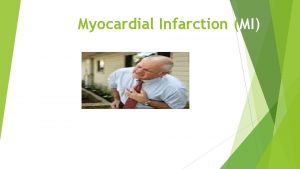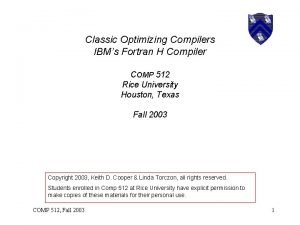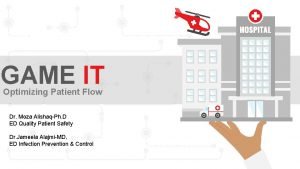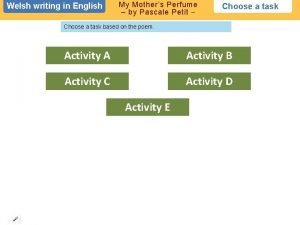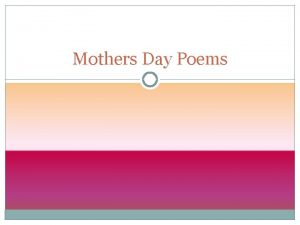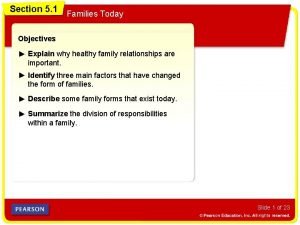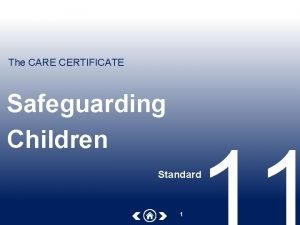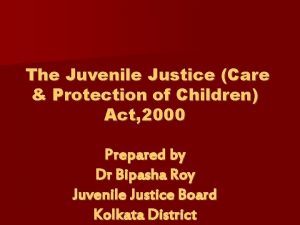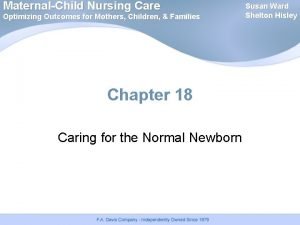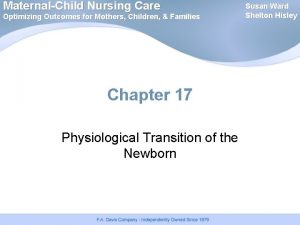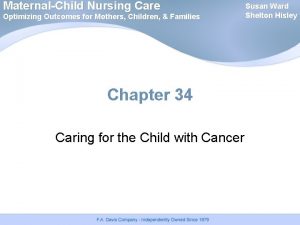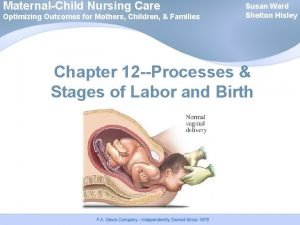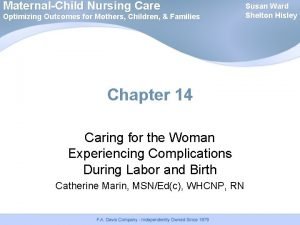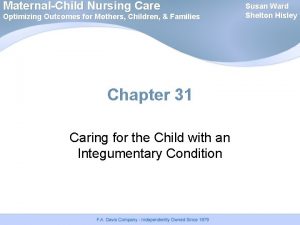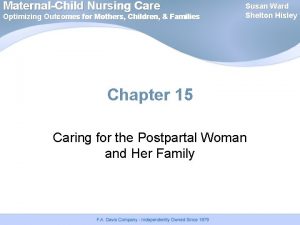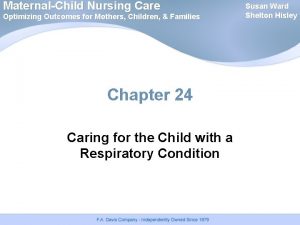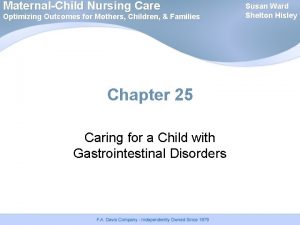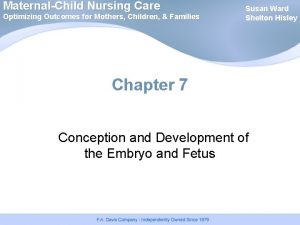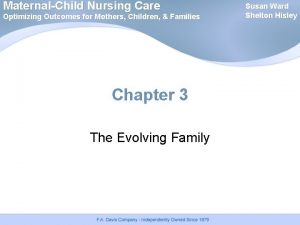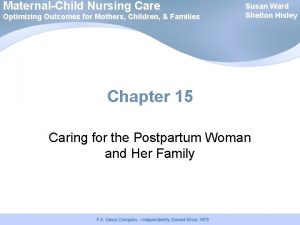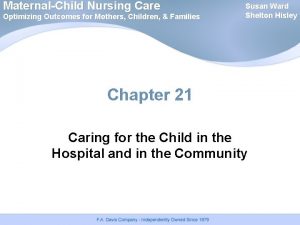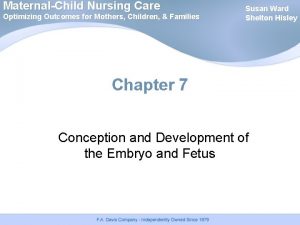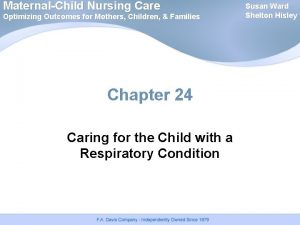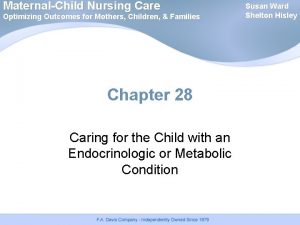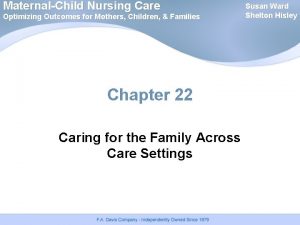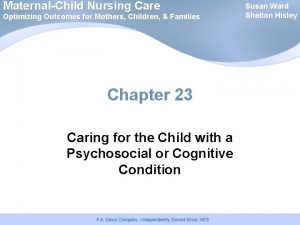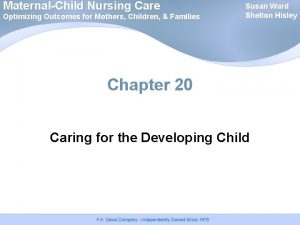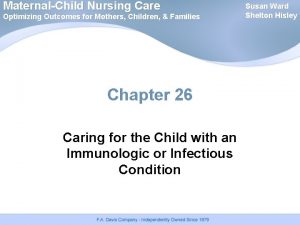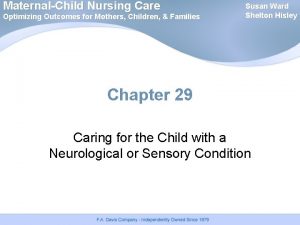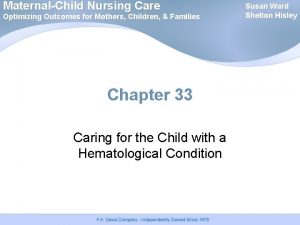MaternalChild Nursing Care Optimizing Outcomes for Mothers Children






































- Slides: 38

Maternal-Child Nursing Care Optimizing Outcomes for Mothers, Children, & Families Susan Ward Shelton Hisley Chapter 32 Caring for the Child with a Renal, Urinary Tract, or Reproductive Condition

A & P Review § Outer cortex § Composed of the glomeruli and convoluted tubules of the nephron and blood vessels § Inner medulla § Composed of the renal pyramid

Fluid and Electrolyte Balance § Compared to adults, children are at a greater risk for fluid and electrolyte imbalance. Children have: § § § § § A proportionately greater amount of body water Require more fluid intake and subsequently excrete more fluid A greater body surface area and a higher percentage of total body water A greater potential for fluid loss via the gastrointestinal tract and skin An increased incidence of fever, upper respiratory infections, and gastroenteritis A greater metabolic rate Immature kidneys that are inefficient at excreting waste products Kidneys that have a decreased ability to concentrate urine Increased risk for developing hypernatremia based on their inability to verbalize thirst

Calculation of Daily Maintenance Fluid Requirements There are two methods of fluid maintenance. The surface area method is the most common and is used for children >22 lb (10 kg): 1500– 2000 m. L/m 2 per day Child’s Weight 0– 10 kg (0– 22 lbs) 11– 20 kg (24. 2– 44 lbs) >20 kg (>44 lbs) Daily Maintenance Fluid Requirement 100 m. L/kg of body weight 1000 m. L + 50 m. L/kg for each kg >10 1500 m. L + 20 m. L/kg for each kg >20 Note: The method used to measure normal urinary output is 1– 2 m. L/kg per hour.

Types of Dehydration § Isotonic § Dehydration occurs when electrolyte and water deficits are present in balanced proportions (sodium and water are lost in equal amounts). § Serum sodium remains in normal limits of 130– 150 m. Eq/L. § This is the most common type of dehydration. Hypovolemic shock is the greatest concern. § Hypotonic § Dehydration occurs when the electrolyte deficit exceeds the water deficit. § The serum sodium concentration is <130 m. Eq/L. § Physical signs are more severe with smaller fluid losses. § Hypertonic § Dehydration is the most dangerous type and occurs when water loss is in excess of electrolyte loss. § The sodium serum concentration is >150 m. Eq/L. § Seizures are likely to occur.

Nursing Care § § § Obtain daily weights Measure intake and output Assess hydration status Laboratory tests include specific gravity, hematocrit, blood urea nitrogen (BUN), creatinine, Na+, K+ and CA++ Assess type of acid-base disturbance Administer oral clear liquids as ordered (1– 2 oz every hour) Start an IV for fluid and electrolyte replacement as ordered Ensure that the child has voided prior to administering intravenous Potassium (K+) Cleanse perineal area and apply protective topical ointment Encourage parents to be involved in the care of child Educate parents about signs and symptoms of dehydration, re-hydration, and when to call the doctor Encourage parents to be compliant with follow-up appointment(s)

Disorders of the Renal and Urinary Systems

Urinary Tract Infections § Signs and symptoms § School-age new enuresis, strong-smelling urine, urgency, flank pain, and changes of personality § Nursing care § § § Collaborate with patient, family, and health care providers Explain treatment process to family Obtain history Administer IV fluids Administer oral or IV antibiotics Keep track of intake and output and odors

Vesicoureteral Reflux (VUR) § Signs and symptoms § Recurrent UTI, flank pain, abdominal pain, and enuresis § Nursing care § Surgery (reimplanting the ureter) § Medical management (antibiotics and anticholinergic agents) § Educate the parents about signs and symptoms of UTI and the importance of medication § Postsurgical—manage intake and output, pain control and infection

Unexplained Proteinuria § Signs and symptoms § Positive proteinuria by dipstick § Nursing care § Outpatient setting—instruct parent how to obtain a first-morning voided specimen § Educate parents about other urological tests § Reinforce proper follow-up care

Hematuria § Signs and symptoms § Blood in the urine § Nursing care § Educate parents and child about laboratory and procedural tests § Explain cause of hematuria § Educate parents and child about proper techniques of collecting a urine specimen § Test urine with a dipstick

Post-Streptococcal Glomerulonephritis § Signs and symptoms § Gross hematuria, either tea- or coffee-colored urine, periorbital edema § Nursing care § Give antibiotic therapy § Monitor fluid intake and output § Administer diuretic medications and antihypertension drugs § Teach family that severe glomerulonephritis may require peritoneal dialysis or hemodialysis § Support family § Assess child pharynx and upper respiratory tract for signs of acute infection § Obtain a streptococcal culture (rapid or full streptococcal culture) § Monitor for hypertension and urinary output § Asses for risk of renal failure § Educate parents about dietary restrictions (sodium, potassium, and fluid intake)

Hemolytic Uremic Syndrome § Signs and symptoms § Gastroenteritis (diarrhea and vomiting), as well as upper respiratory tract infection § Triad—thrombocytopenia, anemia, and acute renal failure (pallor, lethargy, anorexia, anemia, and irritability) § Nursing care § Tell family that child may be in the intensive care unit § Monitor intake and output, LOC, signs of ICP, CHF, bleeding, and hypertension § Monitor daily weights, electrolyte imbalances, and arterial blood gas § Assess BUN and creatinine (renal status worsening) § Assess lungs for CHF § Assess peripheral and periorbital edema § Monitor vital signs § Tell family that electrocardiographic monitoring is recommended § Understand that antibiotics are contraindicated

Henoch-Schonlein Purpura (HSP) § Signs and symptoms § Hematuria and hypertension, bloody diarrhea, crampy abdominal pain, purpural rash § Joint pain and swelling, scrotal swelling § Nursing care § Administer corticosteroids § Discuss immunosuppressant medications and possibility of renal transplant § Monitor for signs of bleeding, pallor, vital sign alterations, abdominal pain, oliguria, and urine abnormalities

Chronic Glomerulonephritis § Signs and symptoms § Decreased urine output, high blood pressure, headaches, and other signs of fluid overload § Nursing care § Manage diet (restrict salt and fluid with low-potassium foods) § Plasma exchange may be instituted in severe cases § If hypertension is present, give diuretics § Carefully monitor urine output, weight, and abdominal girth § Monitor for complications § Develop trusting, supportive, developmentally appropriate relationships § Educate family that long-term follow-up includes biopsies § Note that care is similar to that of acute and chronic renal failure § If renal failure occurs, prepare for dialysis and renal transplant

Structural Defects of the Urinary System

Renal Trauma § Signs and symptoms § Flank tenderness, hematoma, a palpable mass, and other symptoms related to abdominal injury § Nursing care § Follow advanced trauma life-support guidelines § If bruising without any urinary extravasationis found, ensure bedrest, analgesia, and prophylactic; grades IV and V require referral to an urologist § Gather detailed history of problem § Perform nursing assessment, physical examination, and gather crucial information § Surgery may be required (prepare child and family) § After surgery, monitor vital signs, urinary, respiratory, cardiac, GI status, and surgical incision § Monitor intake and output, weight, abdominal girth, administer IV fluids, and manage pain § Report signs of renal perfusion § Address psychosocial care

Acute Renal Failure (ARF) § Signs and symptoms § Fever, rash, bloody diarrhea, pallor, vomiting, diarrhea, abdominal pain, hemorrhage, shock, anuria, or polyuria § Nursing care § § Support parents Administer medications Monitor nutritional intake and fluid intake and output Collaborate with health care team to prevent complications

Chronic Renal Failure § Signs and symptoms § Similar to those of acute renal failure—fever, rash, bloody diarrhea, pallor, vomiting, abdominal pain, hemorrhage, shock, anuria or polyuria § Nursing care § Obtain history § Obtain laboratory results § Give medications § Goals are mutually established with the patient and family § Collaborate with health care team § Facilitate care with nutritionists who will assist with meals § Facilitate pastoral care § Understand that nursing care is based on multisystem organ failure § Provide patient teaching and referral to support groups

Dialysis in Pediatric Nursing

Peritoneal Dialysis § Peritoneal dialysis (the process of dialysis uses the peritoneal membrane to filter blood and purify it) § Nursing care § Assist parents in learning peritoneal dialysis § Monitor for peritonitis (antibiotics, hospitalization, and follow-up) § Monitor abdominal catheter site for signs of infection or malfunctioning equipment § Make certain that the returning dialysate solution remains clear

Hemodialysis § Hemodialysis is dialysis through the blood, using a special machine. Children must be hemodialyzed three times a week at a dialysis center § Signs and symptoms § At the onset, a child may experience several side effects— hypotension, dizziness, nausea, or muscle cramps. § Nursing care § Educate parents on how to keep the AV fistula site clean and safe § No jewelry near access site § No blood pressure on that arm § Avoid carrying heavy objects, sleeping with arm under head or body § Check pulse at the site daily § Promote lifelong coping skills

Renal Transplantation § Renal transplants are received from donors § Children are maintained on dialysis until a kidney is available § Children who receive a transplant are usually in end-stage renal disease § Children receiving transplant must not be immunocompromised § Nursing care § Instruct family about long-term medications that prevent rejection— cyclosporine and steroids § Give antihypertensive and diuretic medication as ordered § Ensure a protein-restricted diet § Facilitate care by accessing other members of the health care team

Functional Disorders of the Urinary Tract

Dysfunctional Elimination Syndrome/Voiding Dysfunction § Signs and symptoms § Frequency, urinary incontinence, and urgency § Nursing care § § Ask child about voiding Monitor stool elimination (maintain a normal bowel routine) Assess for emotional or social problems Teach girls with an inflamed perineum that they can take baking soda sitz baths and use barrier creams § Promote adequate water intake § Administer antibiotics (treatment and prophylaxis)

Enuresis § Signs and symptoms § Primary nocturnal enuresis (PNE) § Do not awaken in response to a full bladder § Secondary nocturnal enuresis (SNE) § UTIs, constipation, diabetes mellitus, obstructive sleep apnea, psychological stress, and urge syndrome with dysfunctional voiding § Nursing care § Administer medications § Desmopressin (DDAVP) § Imipramine (Tofranil) § Educate parents about developmental stage and child who is a deep sleeper § Teach parents about avoidance of fluids close to bedtime § Teach parents to use reward charts § Teach parents that commercial items are available § Teach parents about behavioral treatment (battery-operated bed-wetting alarm)

Exostrophy of the Bladder § Signs and symptoms § Visualization that the bladder is open on the abdominal wall § Nursing care § § § Surgery necessary within the first 48 hours of life Presurgical psychological and medical preparation Postsurgical care Keep area clean Teach caregiver that diaper should be loose fitted and changed frequently

Reproductive Disorders Affecting Girls

Vulvovaginitis § Signs and symptoms § Vulvar itching § Vaginal candidiasis has thick curdy white discharge and is pruritic and foul-smelling (brown or green) § Nursing care § Teach young girls to avoid predisposing factors § Teach young girls about over-the-counter antifungal remedies; applied topically § Instruct young girls to wipe from the front to the back after voiding § Educate patients about complementary treatments

Labial Adhesions § Signs and symptoms § Thin film develops over the labia § Nursing care § Communicate that spontaneous resolution may occur over time § Teach family about lysis of adhesions § Treat with hormone cream § Inform family that complications may include UTI

Amenorrhea § Signs and symptoms § Primary amenorrhea—delayed puberty § Secondary amenorrhea—s/s of pregnancy § Hypothyroidism—dry skin, dry hair, fatigue, hoarseness, constipation, and enlarged thyroid gland § Hyperthyroidism—oily skin and hair, diaphoresis, tachycardia, diarrhea, and a goiter § Polycystic ovarian syndrome—excessive hair and obesity § Corpus luteum cysts—pain in lower quadrants § Nursing care § Educate about pregnancy § Assist with constructing a calendar depicting abnormal menstrual pattern § Assess eating disorders and excessive exercise § Assess family members who experienced amenorrhea

Reproductive Disorders Affecting Boys

Varicocele § Signs and symptoms § § § Feel like a “bag of worms” Distended veins in the scrotum on standing Accentuation of the veins with the Valsalva maneuver Decrease in visibility of the varicocele when in the supine position Small testes § Nursing care § Surgical ligation § Postsurgical nursing care

Cryptorchidism § Signs and symptoms § A retractile testis has descended but retracts with exam and physical stimulation § An ectopic testes is outside of the normal pathway § Nursing care § Surgical repair; orchiopexy done between ages 1 and 2 § Instruct caregiver to have the child wear loose clothing and use analgesics as ordered § Instruct caregiver to observe for erythema, purulent discharge, fever, and increased pain at the incision site (indicative of infection) § Instruct caregiver to change diapers more frequently and avoid having the older child engage in sports or straddle riding toys that might injure the surgical site

Hypospadias and Epispadias § Signs and symptoms § Hypospadias—opening of urethra below the tip on the bottom side of the penis § Epispadias—opening of the urethra above the tip of the penis § Nursing care § Surgery performed before 18 months and before toilet training (urethral stent, Foley catheter in place, and compression dressing applied) § Instruct parents to have the child soak in warm water for 20 minutes before the surgical follow-up appointment (loosen the dressing) § Assess for postsurgical complications § Monitor for signs of infection § Watch for evidence of UTI § Assess pain (oxybutynin chloride relieves bladder spasms) § Assess parent’s knowledge deficit and feelings

Testicular Torsion § Signs and symptoms § Neonate—scrotum appears dusky colored, a solid mass is palpated, scrotal edema, and minimal pain § Older males—severe and persistent pain § Nursing care § Surgery within 4– 8 hours § Postoperative care

Reproductive Disorders Affecting Both Girls & Boys

Ambiguous Genitalia § Signs and symptoms § External reproductive organs not easily identified as male or female § Nursing care § Discuss endocrinology and genetic referrals § Surgery
 Ocd nursing care plan ppt
Ocd nursing care plan ppt Post operative nursing care plan for cataract
Post operative nursing care plan for cataract Primary secondary tertiary care nursing
Primary secondary tertiary care nursing Nursing outcome classification
Nursing outcome classification Pathophysiology of angina
Pathophysiology of angina How is economizing different from optimizing?
How is economizing different from optimizing? Syncthreads
Syncthreads Cuda parallel reduction
Cuda parallel reduction The fortran optimizing compiler
The fortran optimizing compiler Dr moza
Dr moza My mother's perfume poem
My mother's perfume poem Thank god for moms
Thank god for moms Proverbs 31 mother's day poem
Proverbs 31 mother's day poem Happy godmothers day gif
Happy godmothers day gif Father's day in turkey
Father's day in turkey Happy mother day chinese
Happy mother day chinese God's plan for mothers
God's plan for mothers A pack of blessings light upon thy back
A pack of blessings light upon thy back Happy mothers day poems
Happy mothers day poems Tracing family descent through mothers rather than fathers
Tracing family descent through mothers rather than fathers Two mothers one on one
Two mothers one on one 5-1 changing households
5-1 changing households Prayer points for safe delivery
Prayer points for safe delivery May 14 2006
May 14 2006 Safeguarding children care certificate
Safeguarding children care certificate Nj children's system of care
Nj children's system of care Juvenile act
Juvenile act Fspos
Fspos Typiska novell drag
Typiska novell drag Nationell inriktning för artificiell intelligens
Nationell inriktning för artificiell intelligens Ekologiskt fotavtryck
Ekologiskt fotavtryck Shingelfrisyren
Shingelfrisyren En lathund för arbete med kontinuitetshantering
En lathund för arbete med kontinuitetshantering Kassaregister ideell förening
Kassaregister ideell förening Personlig tidbok för yrkesförare
Personlig tidbok för yrkesförare Sura för anatom
Sura för anatom Förklara densitet för barn
Förklara densitet för barn Datorkunskap för nybörjare
Datorkunskap för nybörjare Boverket ka
Boverket ka




